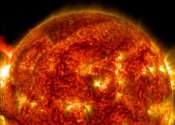Ocean currents predicted on Enceladus
Buried beneath 20 kilometers of ice, the subsurface ocean of Enceladus—one of Saturn's moons—appears to be churning with currents akin to those on Earth.

Buried beneath 20 kilometers of ice, the subsurface ocean of Enceladus—one of Saturn's moons—appears to be churning with currents akin to those on Earth.
Planetary Sciences
Mar 25, 2021
0
2537

At a glacier near the South Pole, earth scientists have found evidence of a quiet, slow-motion fault slip that triggers strong, fast-slip earthquakes many miles away, according to Cornell University research published in ...
Earth Sciences
Feb 16, 2021
0
214

Despite our long history with Earth's closest celestial neighbor, much remains unknown about the moon, including about asymmetries between its near side and far side, for example, in crustal thickness and evidence of volcanic ...
Planetary Sciences
Feb 16, 2021
0
244

Weather systems responsible for transporting moisture from the tropics to temperate regions in the Southern Hemisphere have been gradually shifting toward the South Pole for the past 40 years, a trend which could lead to ...
Earth Sciences
Nov 23, 2020
2
62

The impact of sea surface temperature variations in the tropical Pacific on global climate has long been recognized. For instance, the episodic warming of the tropical Pacific during El Niño events causes melt of sea ice ...
Environment
Nov 20, 2020
5
238

A network of salty ponds may be gurgling beneath Mars' South Pole alongside a large underground lake, raising the prospect of tiny, swimming Martian life.
Space Exploration
Sep 28, 2020
5
1271

NASA on Monday revealed its latest plan to return astronauts to the Moon in 2024, and estimated the cost of meeting that deadline at $28 billion, $16 billion of which would be spent on the lunar landing module.
Space Exploration
Sep 22, 2020
37
1544

A CIRES-led team has uncovered a critical connection between winds at Earth's equator and atmospheric waves 6,000 miles away at the South Pole. The team has found, for the first time, evidence of a Quasi-Biennial Oscillation ...
Earth Sciences
Aug 17, 2020
1
212

Solar flares—violent explosions on the surface of the sun—can send blasts of radiation hurtling toward Earth. While the planet's magnetic field protects humans on the surface, powerful solar flares can disable satellites, ...
Space Exploration
Jul 31, 2020
135
326

For the past decade, an international team of astronomers, led in part by Brent Tully at the University of Hawaiʻi Institute for Astronomy, has been mapping the distribution of galaxies around the Milky Way. They have discovered ...
Astronomy
Jul 13, 2020
5
428